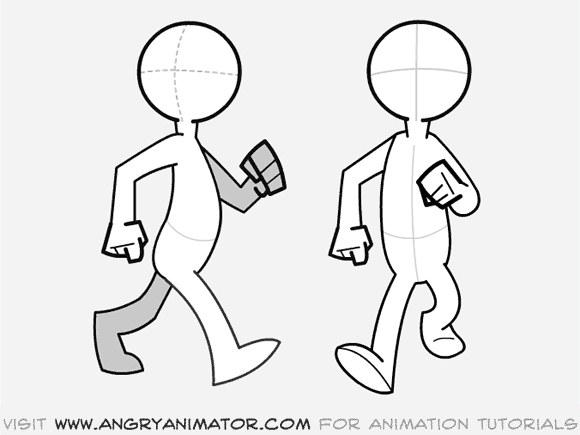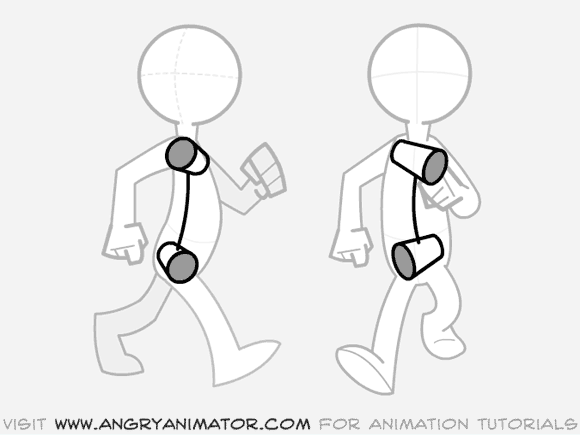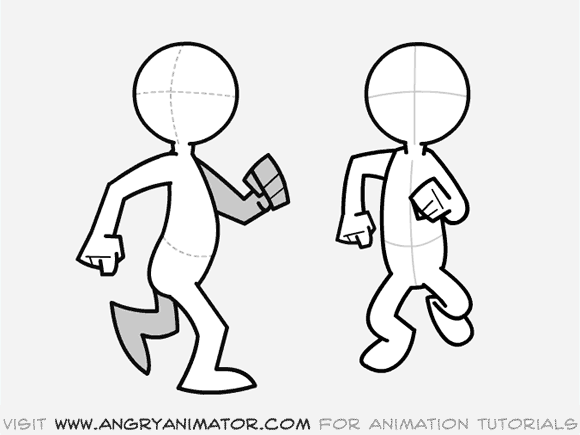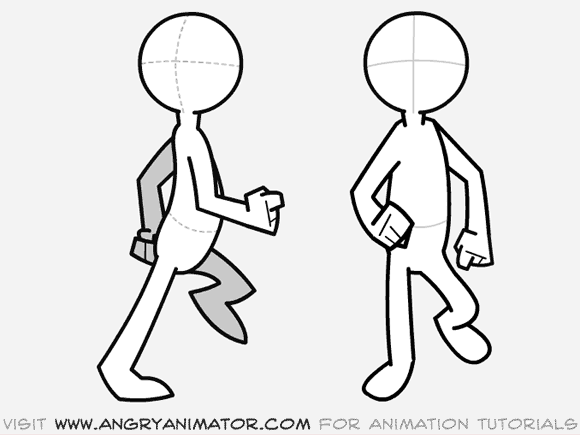CONTACT, RECOIL, PASSING and HIGH-POINT.

These four poses and a handful of inbetween drawings constitute a walk cycle. The single most important frame of the four is the contact pose. Once you draw it you have already determined 80% of the rest of your walk. If you make a mistake on your contact pose, it can be very difficult to correct later on. Therefore: pay close attention now and save yourself a world of pain.
Here is the contact pose in front and side view.
 Look at the pose carefully. You will notice some very important details: The feet are at their furthest extension in the walk. That is their most extreme position in the cycle. That alone makes this the most critical pose in the sequence. You can plan an entire walk sequence just by laying out all the contact poses as they work into one another.
Look at the pose carefully. You will notice some very important details: The feet are at their furthest extension in the walk. That is their most extreme position in the cycle. That alone makes this the most critical pose in the sequence. You can plan an entire walk sequence just by laying out all the contact poses as they work into one another.
Some animators think that the recoil and high points are the most important poses because the head is at its highest and lowest positions. This is wrong. The contact pose is the fundamental building block of a walk cycle. If you do not start your cycle with this pose, then you are doomed. It’s as simple as that.
When the right foot is forward, the right arm is back, and vice versa. This is called “counterpose”. This is how nature keeps everything in balance when you move: one side of the body “opposes” the other. Good animation has these “opposing actions” all the time. If animation seems weak or unnatural to you, it is frequently because it lack opposing action. You can think of a walk as a series of “falls”. The character propels himself forward by leaning into the walk as he moves forward. His trailing foot constantly swings forward to catch himself before he moves on to the next “fall” in the sequence. It shares many attributes with the bouncing ball in tutorial 1. Look at the front on view.

I have drawn in imaginary cylinders to illustrate the orientation of the shoulders and hips. Again, as one is thrust forward, the other is thrust back. As one tilts up, the other tilts down.
Another name for this is “Torque”. It is a fundamental principle of good posing. It should be an element of almost every figure drawing that you do. Michelangelo always used torque in his sculptures, creating dynamic poses, even in ones that were standing still. One hip takes the weight, while the other passively provides the balance.
The body is very rarely symmetrical: indeed, symmetry can be your enemy.
Now look at the recoil pose, the second main pose in the cycle.

This is the frame where the character impacts the ground. It is also the lowest point in the cycle. The characters arms are furthest from the body as a result of the force of hitting the ground. The front foot is fully in contact with the ground; the rear foot has just lifted up from it.
Note that the leading foot is directly beneath the body, supporting the weight above it. Too many beginners produce recoil poses where the foot is not beneath the body, but several inches ahead of it. Try to avoid this.
To keep things simple, let’s skip the passing pose…it’s closer to being an inbetween. Let’s look at the high point.

This is the highest point in the cycle. The character’s body is stretched to the maximum as he lifts his leading leg forward to reach the next contact position. The heel of the trailing foot is just beginning to leave the ground.
Those are the three most important poses to remember when creating a walk animation. If you can wrap your head around them, you will have a much better chance of completing a satisfactory walk cycle.
There are two basic ways to animate a walk cycle. You can animate the cycle “in place” or across the screen. Here is the same scene shown in each style.
No comments:
Post a Comment